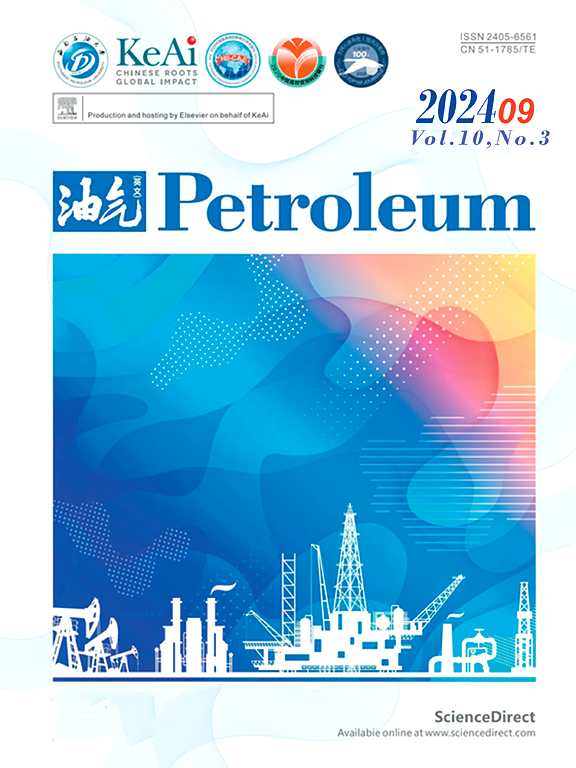Optimization design of natural gas differential pressure power generation under flow fluctuation
IF 4.2
Q2 ENERGY & FUELS
引用次数: 0
Abstract
“Double carbon” is a two-stage carbon emission reduction goal proposed by China, and differential pressure power generation, as a natural gas (NG) residual pressure energy power generation technology, can effectively utilize natural gas residual pressure energy and also realize zero carbon emission. Aiming at the problem of low efficiency of differential pressure power generation due to the large fluctuation of natural gas flow rate, this paper calculates the potential of differential pressure power generation by using the exergy analysis method and confirms the feasibility of differential pressure power generation. Meanwhile, three optimization schemes are proposed to enhance the efficiency of pressure energy utilization in the purification plant, and economic analysis is used to compare the optimization results. Calculation results show that: when the average flow rate of natural gas is m3/d, the theory of using differential pressure power generation can convert kW·h of electric energy per year, while the case's annual power generation is kW·h, which accounts for 58% of the theory; optimization results show that: the optimize the duration of power generation scheme, continuous power generation scheme, and high efficiency power generation scheme increase the annual power generation compared to the case by 5%, 9%, and 11%, and the net profit increases by 1.6%, 4.9%, and 10% respectively; therefore, it is feasible to adopt natural gas differential pressure power generation technology in purification plant, in which the payback period of high-efficiency power generation scheme is the shortest, only 3.24 years.
流量波动下天然气差压发电优化设计
“双碳”是中国提出的两阶段碳减排目标,而差压发电作为天然气余压能发电技术,既能有效利用天然气余压能,又能实现零碳排放。针对天然气流量波动大导致的差压发电效率低的问题,采用火用分析方法计算了差压发电的潜力,确认了差压发电的可行性。同时,为提高净化装置压力能利用效率,提出了3种优化方案,并对优化结果进行了经济分析比较。计算结果表明:当天然气平均流量为300×104 m3/d时,采用差压发电理论每年可转换电能647.3×104 kW·h,而实例年发电量为376.3×104 kW·h,占理论发电量的58%;优化结果表明:优化后的发电方案、连续发电方案、高效发电方案的年发电量比方案分别提高5%、9%、11%,净利润分别提高1.6%、4.9%、10%;因此,净化装置采用天然气差压发电技术是可行的,其中高效发电方案投资回收期最短,仅为3.24年。
本文章由计算机程序翻译,如有差异,请以英文原文为准。
求助全文
约1分钟内获得全文
求助全文
来源期刊

Petroleum
Earth and Planetary Sciences-Geology
CiteScore
9.20
自引率
0.00%
发文量
76
审稿时长
124 days
期刊介绍:
Examples of appropriate topical areas that will be considered include the following: 1.comprehensive research on oil and gas reservoir (reservoir geology): -geological basis of oil and gas reservoirs -reservoir geochemistry -reservoir formation mechanism -reservoir identification methods and techniques 2.kinetics of oil and gas basins and analyses of potential oil and gas resources: -fine description factors of hydrocarbon accumulation -mechanism analysis on recovery and dynamic accumulation process -relationship between accumulation factors and the accumulation process -analysis of oil and gas potential resource 3.theories and methods for complex reservoir geophysical prospecting: -geophysical basis of deep geologic structures and background of hydrocarbon occurrence -geophysical prediction of deep and complex reservoirs -physical test analyses and numerical simulations of reservoir rocks -anisotropic medium seismic imaging theory and new technology for multiwave seismic exploration -o theories and methods for reservoir fluid geophysical identification and prediction 4.theories, methods, technology, and design for complex reservoir development: -reservoir percolation theory and application technology -field development theories and methods -theory and technology for enhancing recovery efficiency 5.working liquid for oil and gas wells and reservoir protection technology: -working chemicals and mechanics for oil and gas wells -reservoir protection technology 6.new techniques and technologies for oil and gas drilling and production: -under-balanced drilling/gas drilling -special-track well drilling -cementing and completion of oil and gas wells -engineering safety applications for oil and gas wells -new technology of fracture acidizing
 求助内容:
求助内容: 应助结果提醒方式:
应助结果提醒方式:


